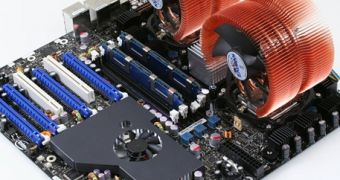Intel has just launched its new 8-core enthusiast platform, the Skulltrail, and the company expects that it will get widely adopted within the enthusiast and gaming communities all over the world. The advent of the Skulltrail platform was strategically planned to kick AMD's Spider platform straight in the gut, although the Spider has nothing to do with either gaming community or dual-socket layouts.
The Skulltrail is an extreme manifestation of power that was aimed at letting the world know who the daddy is when it comes to computing. The platform's very structure hints the fact that it is more of a server rather than an average workstation. The dual-CPU LGA 771 sockets can be rigged with a set of two Core 2 Extreme QX9975 chips packing four cores running at 3.2GHz, with 12MB of L2 cache, a fast 1600 MHz system bus each. Intel packed all its best products in a single system, then painted a skull and a two crossed bones.
The next obvious step Intel will take is to re-baptize the platform using a more appropriate name, given the fact that the Skulltrail was just a temporary codename that proved itself to be quite catchy. The corporation has however hinted the customers that they will be able to get the new killing machine under a new and extremely long / boring name: the Intel Dual Socket Extreme Desktop Platform.
"When it comes to delivering innovation to the ultimate enthusiast, our new 8-core desktop platform is a winner," said Jeff McCrea, senior vice president and general manager of Intel's Digital Home Group. "The ground-breaking Intel Desktop Board D5400XS enables the flexibility to pair a variety of quad graphics solutions with two of our fastest desktop processors. The result is stunning PC performance," he continued.
It seems that the killing machine is extremely appealing to game programmers and developers, too. "Having eight powerful Intel cores in a single machine helps our team create and test our latest titles at record speed," claimed Robert A. Duffy, programming director at id Software. "We have seen one of our most time-consuming asset generation processes cut from over four hours to under 20 minutes by utilizing all eight cores and threading the generation code. Long term this translates to better games on the market faster than previously possible."

 14 DAY TRIAL //
14 DAY TRIAL //